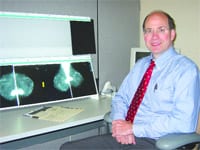CDH Installs MRI Unit at Amherst Outpatient Center
AMHERST — Residents living east of the Connecticut River now have access to a new magnetic resonance imaging (MRI) system that features an extra-large opening for patients of all sizes and people who experience claustrophobia. The new MRI unit is located at the Cooley Dickinson Amherst Outpatient Center.
The Massachusetts Department of Public Health issued Cooley Dickinson Hospital a certificate of occupancy for the MRI unit that is housed within the Imaging/Radiology department at the 170 University Drive location. The first patients were seen on May 15.
“There was a need to bring MRI services to the greater Amherst area,” Kenneth Guilbault, vice president of Ambulatory Services, said of the second MRI owned and operated by CDH. “This investment in services for local residents is at the core of what a community hospital is about.”
Dr. Paul Kolbjornsen, chief of Radiology, said the CDH radiologists are very enthusiastic about expanding imaging services. With the new MRI magnet, “the image quality is outstanding, while scan times are shortened, often resulting in a better patient experience,” he said. “The opening of this MRI is another demonstration of Cooley Dickinson’s ongoing commitment to maintaining state-of-the-art equipment in our community, which is a critical component in our medical staff’s ability to diagnose and expeditiously treat our patients’ problems.
“In addition to improved access to high-quality MRI,” he added, “we are coupling the opening of the new scanner with expanded services such as breast MRI, which we plan to begin offering within the next two months.”
Nancy King, director of Imaging Services, said the Amherst MRI combines a larger bore, or opening, with the same high-field quality diagnostic images that are available at the hospital’s MRI center in Northampton. “The patient-friendly design of this magnet will make it easier for those with claustrophobia to have MRI exams,” she explained. “This open MRI is also better for performing diagnostic imaging on children.”
Additionally, the MRI table can accommodate people who weigh up to 500 pounds. “Previously, CDH was unable to accommodate patients weighing more than 350 pounds,” King said. “This additional unit, specifically designed for bariatric or clinically obese patients, means that they can visit their local health care facility for diagnostic care.”
The equipment allows more than 60{06cf2b9696b159f874511d23dbc893eb1ac83014175ed30550cfff22781411e5} of exams to be completed with the patient’s head outside of the opening of the bore. The unit measures nearly 2.3 feet in diameter and provides almost one foot of free space between a patient’s head and the magnet.
MRI is one of the most advanced procedures physicians use to diagnose many conditions or injuries. It uses strong magnet fields and radiofrequency waves to produce pictures or images of internal organs, muscles, connective tissue, or the central nervous system.
An MRI exam gives physicians a wealth of information which may not be apparent on any other tests, procedures, and even exploratory surgeries. MRI does not use radiation; it offers a painless, non-invasive way to obtain information about the patient.


Comments are closed.